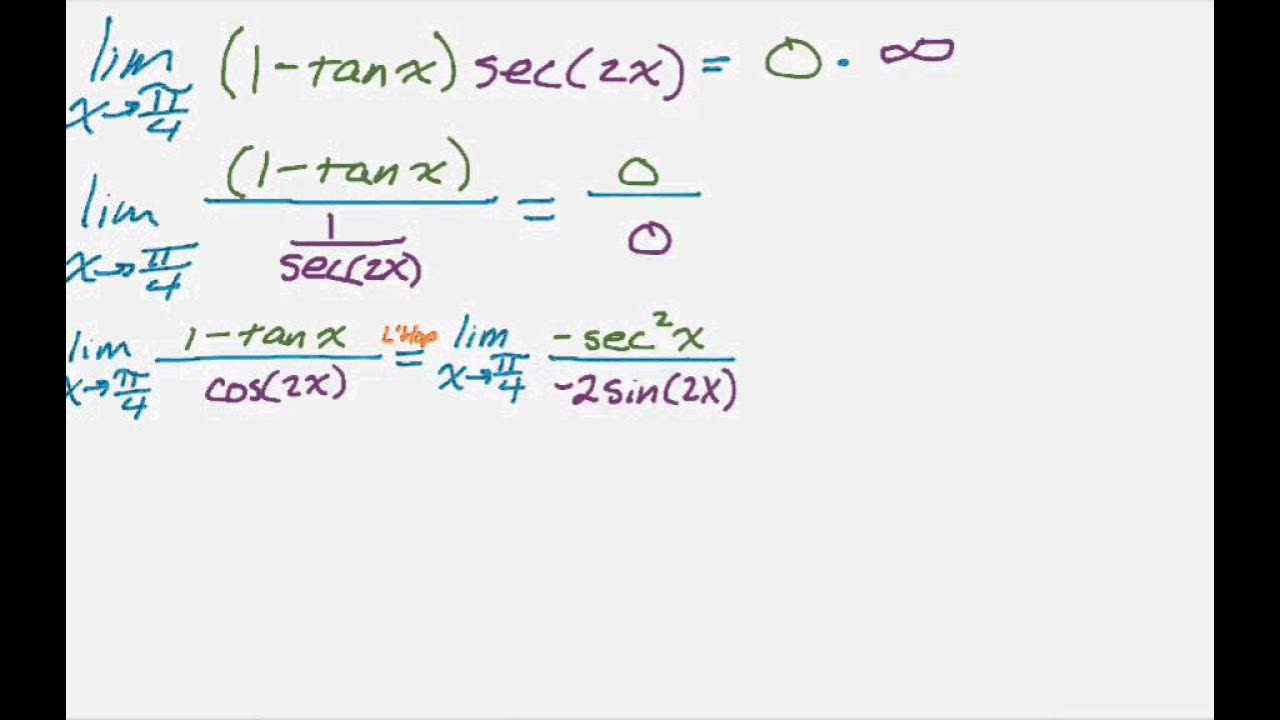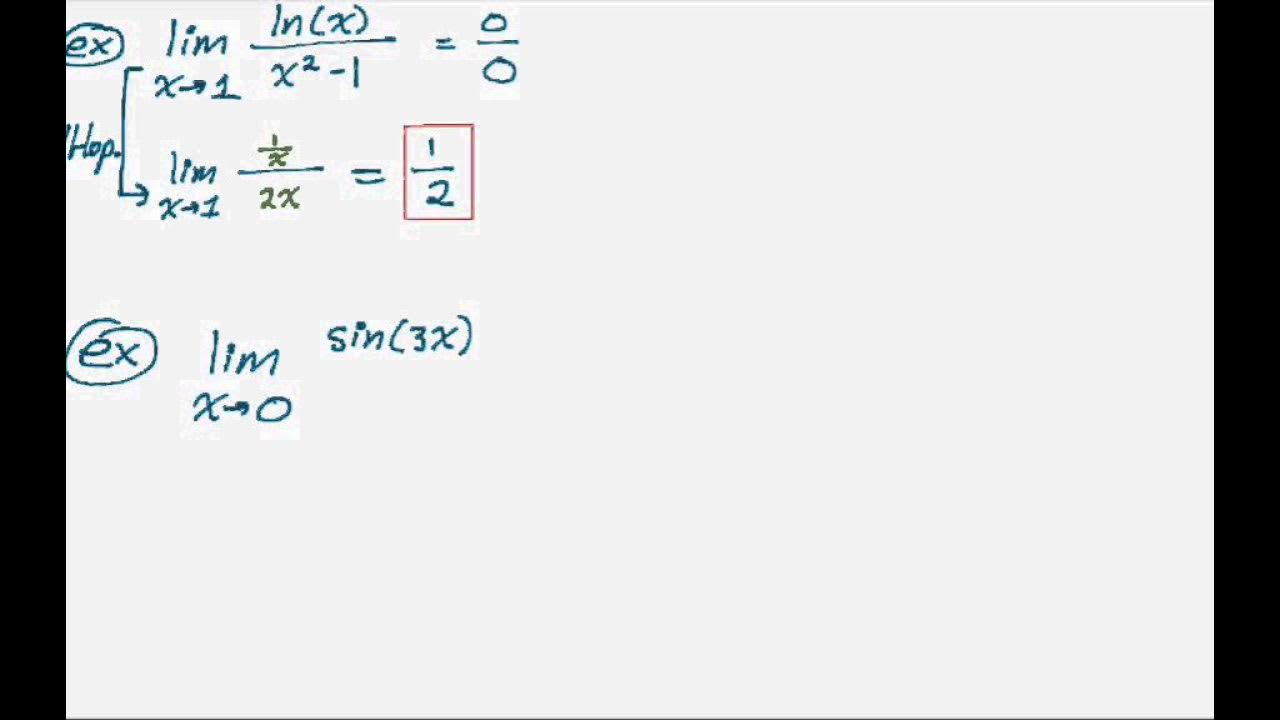l'Hospital Practice | MIT 18.01SC Single Variable Calculus, Fall 2010
TLDRIn this recitation video, the professor introduces l'Hôpital's rule, a powerful tool for computing limits that were previously challenging. The script walks through four limit problems, demonstrating when and how to apply the rule, especially for 0/0 and ∞/∞ indeterminate forms. The professor simplifies the first limit to a straightforward ratio, uses the rule to find the derivative of sine(5x) at 0, points out when the rule is inapplicable, and finally, applies the rule to an ∞/∞ form, concluding that the limit approaches 3/2. The session emphasizes the importance of recognizing indeterminate forms before applying l'Hôpital's rule.
Takeaways
- 📚 The lecture introduces l'Hôpital's rule, a mathematical tool for computing limits that were previously difficult to solve.
- 🔍 L'Hôpital's rule is applicable to limits that are in indeterminate forms such as 0/0 or ∞/∞.
- 📉 When applying l'Hôpital's rule, the derivatives of the numerator and denominator are taken, and the limit of the new expression is considered if it exists.
- 🔄 The rule simplifies the process by transforming the original limit into a potentially more straightforward one.
- 🧩 In the first example, the limit as x approaches 1 of (x^a - 1) / (x^b - 1) simplifies to a/b after applying l'Hôpital's rule.
- 📈 For the second example, the limit as x approaches 0 of (sin(5x) / x) is computed to be 5 using l'Hôpital's rule, which is also the derivative of sin(5x) at x=0.
- ❌ In the third example, l'Hôpital's rule is not applicable because the limit as x approaches 0 of (x^2 - 6x + 2) / (x + 1) is already determinate and equals 2.
- 🌐 The fourth example involves the limit as x approaches ∞ of (ln(1 + e^(3x)) / (2x + 5)), which is an indeterminate ∞/∞ form and can be solved using l'Hôpital's rule.
- 🔄 After applying l'Hôpital's rule to the fourth example, the limit simplifies to 3/2 by recognizing that the dominant terms in the numerator and denominator are e^(3x).
- 📝 It's important to verify that the limit is in an indeterminate form before applying l'Hôpital's rule, ensuring the rule's appropriate use.
- 🔑 The lecture emphasizes the utility of l'Hôpital's rule in computing limits and provides a step-by-step guide on its application.
Q & A
What is l'Hopital's rule used for in the context of the lecture?
-L'Hopital's rule is used for computing limits that are difficult to evaluate, especially those that result in indeterminate forms such as 0/0 or ∞/∞.
What is the first condition to check before applying l'Hopital's rule?
-The first condition to check is whether the limit is in an indeterminate form, such as 0/0 or ∞/∞, which indicates an indeterminate quotient.
In the script, what is the limit (a) and how is it simplified using l'Hopital's rule?
-The limit (a) is the limit as x goes to 1 of (x^a - 1) / (x^b - 1). It is simplified using l'Hopital's rule by taking the derivatives of the numerator and the denominator and evaluating the new limit, which simplifies to a / b.
Why is l'Hopital's rule not applicable to part (c) of the script?
-L'Hopital's rule is not applicable to part (c) because the limit as x goes to 0 of (x^2 - 6x + 2) / (x + 1) is not an indeterminate form; it can be directly computed by substituting x with 0, resulting in 2.
What is the limit (b) in the script, and how is it evaluated?
-The limit (b) is the limit as x goes to 0 of sin(5x) / x. It is evaluated using l'Hopital's rule, which results in the derivative of the numerator (5cos(5x)) over the derivative of the denominator (1), simplifying to 5cos(0), which equals 5.
Why did the professor mention that l'Hopital's rule was not necessary for part (b)?
-The professor mentioned that l'Hopital's rule was not necessary for part (b) because the limit is actually the definition of the derivative of sin(5x) at x equals 0, which is known to be 5.
What is the limit (d) in the script, and how is it approached?
-The limit (d) is the limit as x goes to infinity of ln(1 + e^(3x)) / (2x + 5). It is approached by recognizing it as an ∞/∞ indeterminate form and applying l'Hopital's rule, which simplifies to 3/2 after considering the dominant terms in the expression.
What is the significance of the 'dominant terms' in the analysis of limit (d)?
-The significance of the 'dominant terms' is that they determine the behavior of the function as x approaches infinity. In limit (d), e^(3x) becomes the dominant term, making the ratio approach 1, and thus the limit is 3/2.
Can l'Hopital's rule be applied multiple times if the resulting limit is still indeterminate?
-Yes, l'Hopital's rule can be applied multiple times if the resulting limit is still in an indeterminate form, such as 0/0 or ∞/∞, until a determinate limit is obtained.
What is the final result of applying l'Hopital's rule to limit (d) in the script?
-The final result of applying l'Hopital's rule to limit (d) is 3/2, after recognizing that the ratio of the derivatives simplifies to 1 due to the dominant terms e^(3x) in both the numerator and the denominator.
Why is it important to check for an indeterminate form before applying l'Hopital's rule?
-It is important to check for an indeterminate form before applying l'Hopital's rule because the rule is specifically designed to handle such forms. Applying it to a determinate form or a limit that can be directly evaluated without the rule is unnecessary and incorrect.
Outlines
📚 Introduction to l'Hopital's Rule
The script opens with a professor welcoming students to a recitation session focused on l'Hopital's rule, a mathematical tool for computing limits. The professor introduces four limit problems, suggesting students attempt them before continuing. The first limit involves the indeterminate form 0/0, which is suitable for l'Hopital's rule. The rule is applied by differentiating the numerator and denominator and evaluating the new limit. The professor simplifies the expression and concludes that the limit is a/b, highlighting the straightforward application of the rule.
🔍 Applying l'Hopital's Rule to Trigonometric Limits
The second paragraph delves into the application of l'Hopital's rule to a trigonometric limit, specifically the limit of sine(5x)/x as x approaches 0. The professor demonstrates that this is another 0/0 indeterminate form, allowing for the use of the rule. After differentiation, the limit simplifies to 5 times the cosine of 0, which is 5. Interestingly, the professor notes that this limit could also be determined by recognizing it as the definition of the derivative of sine(5x) at x=0, thus offering an alternative approach to the problem.
🚫 Limit Calculation Without l'Hopital's Rule
In the third paragraph, the professor addresses a limit that does not require l'Hopital's rule. The limit in question is (x^2 - 6x + 2)/(x + 1) as x approaches 0. The professor explains that this is not an indeterminate form and can be easily computed by direct substitution, yielding a result of 2. The professor emphasizes that while l'Hopital's rule is a powerful tool, it is not always necessary and should only be applied when the limit is in an indeterminate form.
🌐 Evaluating Limits at Infinity with l'Hopital's Rule
The final paragraph discusses the application of l'Hopital's rule to a limit involving natural logarithms and exponential functions as x approaches infinity. The professor identifies the limit as an indeterminate form of infinity over infinity, making it suitable for the rule. After differentiating and simplifying, the professor suggests that the limit approaches 1, based on the dominance of e^(3x) in both the numerator and the denominator. The professor concludes that the final result, when multiplied by 3/2, is 3/2, demonstrating the effectiveness of l'Hopital's rule in handling limits at infinity.
Mindmap
Keywords
💡l'Hopital's rule
💡limits
💡indeterminate form
💡derivative
💡0 over 0
💡infinity over infinity
💡simplification
💡sine function
💡natural logarithm
💡chain rule
Highlights
Introduction to l'Hopital's rule for computing limits that were previously difficult.
Four example limits are presented to practice applying l'Hopital's rule.
Limit (a) involves a 0/0 indeterminate form, suitable for l'Hopital's rule.
Applying l'Hopital's rule to limit (a) simplifies it to a/(1^b), resulting in a/b.
Limit (b) is a 0/0 form with sine(5x)/x, allowing the use of l'Hopital's rule.
The derivative of sine(5x)/x at x=0 is 5, which is also the definition of the derivative of sine(5x).
Limit (c) is not an indeterminate form and does not require l'Hopital's rule.
Direct substitution shows limit (c) equals 2 without needing l'Hopital's rule.
Limit (d) is an ∞/∞ indeterminate form, appropriate for l'Hopital's rule.
Applying l'Hopital's rule to limit (d) involves taking the ratio of derivatives.
The chain rule is used to find the derivative of the natural logarithm in limit (d).
An analysis of magnitudes suggests the limit (d) approaches 1.
Alternatively, applying l'Hopital's rule again confirms the limit (d) is 1.
The final result for limit (d) is 3/2, after simplifying the expression.
Emphasis on checking for indeterminate forms before applying l'Hopital's rule.
Summary of the process of computing four limits, with one not requiring l'Hopital's rule.
Transcripts
Browse More Related Video

Understanding Limits and L'Hospital's Rule

Using L'Hopital's Rule to show that exponentials dominate polynomials

L'Hopital's Rule (Zero Times Infinity)

Introduction to l'Hôpital's rule | Derivative applications | Differential Calculus | Khan Academy

Calculus Chapter 1 Lecture 8 l'Hopital's Rule

L'Hopital's Rule Examples
5.0 / 5 (0 votes)
Thanks for rating: